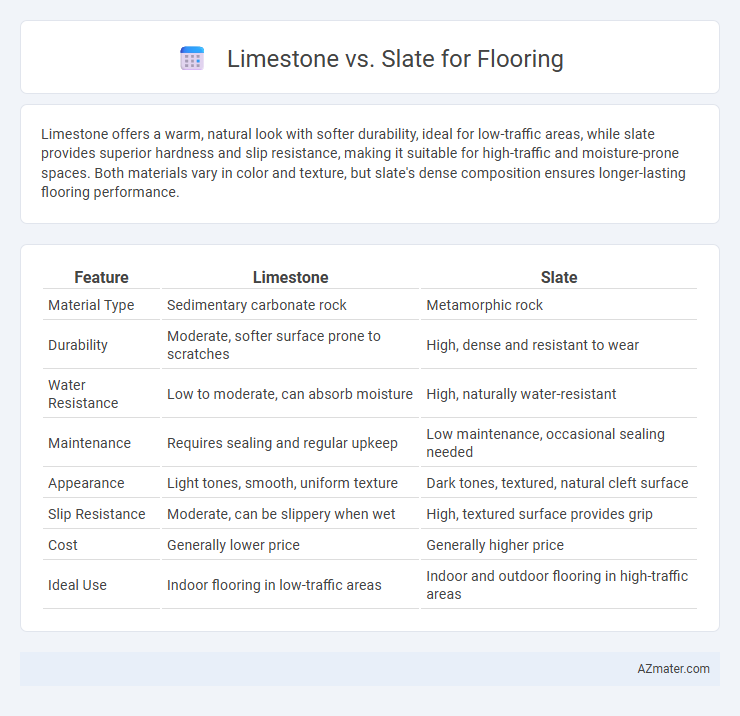Limestone offers a warm, natural look with softer durability, ideal for low-traffic areas, while slate provides superior hardness and slip resistance, making it suitable for high-traffic and moisture-prone spaces. Both materials vary in color and texture, but slate's dense composition ensures longer-lasting flooring performance.
Table of Comparison
| Feature | Limestone | Slate |
|---|---|---|
| Material Type | Sedimentary carbonate rock | Metamorphic rock |
| Durability | Moderate, softer surface prone to scratches | High, dense and resistant to wear |
| Water Resistance | Low to moderate, can absorb moisture | High, naturally water-resistant |
| Maintenance | Requires sealing and regular upkeep | Low maintenance, occasional sealing needed |
| Appearance | Light tones, smooth, uniform texture | Dark tones, textured, natural cleft surface |
| Slip Resistance | Moderate, can be slippery when wet | High, textured surface provides grip |
| Cost | Generally lower price | Generally higher price |
| Ideal Use | Indoor flooring in low-traffic areas | Indoor and outdoor flooring in high-traffic areas |
Introduction to Limestone and Slate Flooring
Limestone flooring offers natural elegance with its soft texture and warm hues, making it ideal for both classic and contemporary interiors. Slate flooring provides exceptional durability and a distinctive, textured surface featuring rich color variations that enhance rustic and modern spaces alike. Both materials are valued for their unique aesthetics and long-lasting performance in residential and commercial flooring applications.
Key Differences Between Limestone and Slate
Limestone flooring offers a soft, warm aesthetic with natural earth tones and a porous texture, while slate provides a durable, dense surface with a varied color palette and a natural cleft finish. Limestone is more prone to scratching and requires regular sealing to prevent staining, whereas slate is more resistant to damage and moisture, making it suitable for high-traffic areas. The choice between limestone and slate depends on factors such as desired appearance, maintenance requirements, and the specific environment of the installation.
Appearance and Aesthetic Appeal
Limestone flooring offers a warm, natural appearance with soft beige and cream hues that create an inviting, rustic ambiance, while slate features a more varied, textured surface with deep greys, greens, and blacks lending a sleek, contemporary aesthetic. The subtle veining and smooth finish of limestone contrast with slate's rougher, layered look that enhances spaces with a dramatic, earthy feel. Both materials add unique character to interiors but limestone suits classic, elegant designs, whereas slate complements modern, industrial styles.
Durability and Longevity Comparison
Limestone flooring offers moderate durability with a hardness rating of 3 to 4 on the Mohs scale, making it susceptible to scratches and acidic stains, which can affect its longevity. Slate ranks higher in durability, with a Mohs hardness of 6 to 7, providing excellent resistance to wear, moisture, and heavy foot traffic, resulting in a longer lifespan. For high-traffic areas requiring long-term resilience, slate is generally a superior flooring choice compared to limestone.
Maintenance Requirements for Limestone vs Slate
Limestone flooring demands regular sealing to prevent staining and water damage due to its porous nature, while slate features higher durability and naturally resists moisture, requiring less frequent sealing. Cleaning limestone involves gentle, pH-neutral cleaners to avoid etching, whereas slate can withstand a broader range of cleaning products without surface damage. Maintenance costs for limestone tend to be higher over time because of its sensitivity, whereas slate offers a more cost-effective, low-maintenance option for long-term flooring solutions.
Slip Resistance and Safety Factors
Limestone offers moderate slip resistance with a naturally textured surface that can become slippery when wet, making it less ideal for high-moisture areas. Slate provides superior slip resistance due to its cleft texture and uneven surface, enhancing safety in both dry and wet conditions. For flooring applications prioritizing slip resistance and safety, slate is generally the preferred choice over limestone.
Installation Process and Costs
Limestone flooring requires sealing to prevent staining and is typically installed using mortar and grout, with installation costs ranging from $5 to $15 per square foot depending on tile size and labor difficulty. Slate flooring demands careful handling due to its natural cleft texture and is installed with thinset mortar, often incurring higher costs between $7 and $20 per square foot because of its durability and precise cutting needs. Both materials require professional installation for optimal results, but limestone generally offers a more budget-friendly option while slate provides enhanced longevity and a unique aesthetic.
Environmental Impact and Sustainability
Limestone flooring offers a natural, durable option with low embodied energy and is often sourced locally, reducing transportation emissions. Slate, being a metamorphic rock, is highly durable and requires minimal processing, contributing to a lower carbon footprint over its lifecycle. Both materials are recyclable and biodegradable, but limestone's abundance and ease of extraction generally make it a more sustainable choice in environmentally-conscious flooring projects.
Best Applications for Limestone and Slate Flooring
Limestone flooring excels in residential interiors such as kitchens, living rooms, and bathrooms due to its natural warmth, durability, and ease of maintenance, making it ideal for moderate traffic areas with consistent environmental conditions. Slate flooring is best suited for high-traffic areas like hallways, entryways, and outdoor patios because of its superior slip resistance, hardness, and weather-resistant properties. Both limestone and slate offer unique aesthetic appeal with limestone providing a softer, more uniform look while slate delivers a textured, rugged appearance suitable for rustic or contemporary designs.
Final Verdict: Which Flooring is Right for You?
Limestone offers a natural, warm appearance with soft, earthy tones ideal for low-traffic, indoor spaces, while slate provides superior durability and a textured, slip-resistant surface suitable for high-traffic and moisture-prone areas. Slate's resistance to scratches, stains, and moisture makes it perfect for kitchens, bathrooms, and outdoor settings, whereas limestone requires regular sealing and maintenance to prevent damage and staining. Choose limestone for its elegance and softer aesthetic in controlled environments and slate for toughness, longevity, and versatility in both residential and commercial flooring applications.

Infographic: Limestone vs Slate for Flooring
 azmater.com
azmater.com